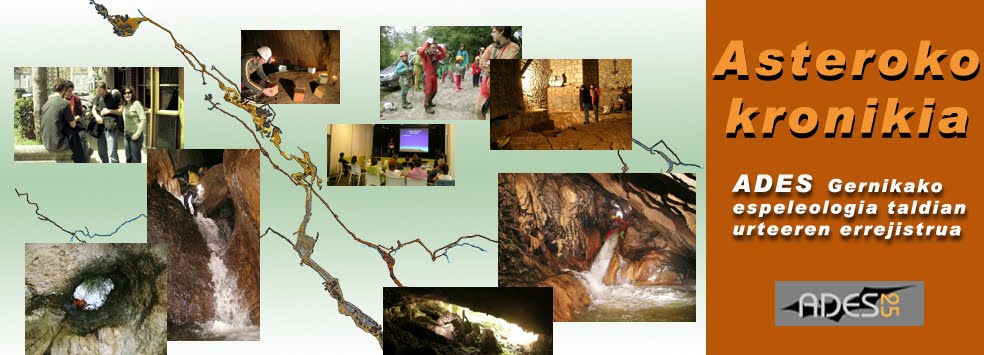 |
| 201207, 14:51etako argazkixa. |
201207: Oier.
Armintxe, limnigrafo publikuan ikustaldixa. Zapatutik eurixa eten barik botatzen diharduanez, gaur astelehena, goizian ikustaldixa egittera juan naiz (9:15). Kontuan hartzekuak:
• Minimo barrixa aktibau egin da: bere aurreko hormigoia garbi, ezker eskumako hormigoian aldian.
• Megalituan eskumako ertzeko urteera multipletik be ura urten da (bedarra zapal), baiña jarixo txikixakin: ez dau orbela guztiz garbittu.
• Kanpofoballeko hobixa eta ubidia berera betetxo, 1,5 inguru.
• Dana argazkixetan jasota.
Datozen orduetan eurixa emonda dago, intentsidade altuaguan gaiñera (asteburuan zihar, une puntual batzuk kenduta, ez dau asko bota).
15:00etako ikustaldixan, megalituan ez dago aldaketarik. Goizian zihar eurixak sendo bota dau. Ubidian, ostera, harri markagailluetan urak 5-10 zm gorago egin dau.
 |
| Mattesek hitzaldian zehar azaldu dizkigun mapa topografikoetako batzuk. |
201207: Simone, Oier.
Arratsaldez, Johannes Mattes espeleologo austriarraren hitzaldian. Edinburgoko Unibertsitatearen STIS sailak (Science, Technology and Innovation Studies), antolatua, eta Simonek berak aurkeztua, speleo historialari honek egindako azken ekarpena azaldu digu, argitaratu aurretik azaldu ere! Bere topografia zaharren bildumako ale ezin ederragoak erakutsiz, irudikatu ezina irudikatu nahiaren erronka aurkeztu digu, prezisioaren eta irudimenaren ezinbesteko nahastea. Bertan ere esan dudana errepikatuko dut: guk topografia egitean askotan aurkitzen garen egoera da, ailegatu ezin garen lekuak mapan jaso beharra, eta "asmatu" dugun hori etorkizuneko espeleologoek nola ikusiko duten imajinatzea... Mattesen ikergaia ikusita, badakigu egiten ditugun akatsekin onberak izango direla, beraz... aurrera.
Jarraian, accuracy gehiagorekin, entzun dugunaren gorabeherak.
"Concepts of Knowledge and Space in Historical Cave Maps (1500-1800)"
Abstract: As places of a specific mediality and polyvalent imagery, caves were of interest for scholars, travelers as well as artists. Serving as a bridge between different cultures of knowledge, the underground, its observation and documentation functioned as a projection screen for the visitor’s claims of interpretation and possession. For scholars as Jacques Gaffarel, Athanasius Kircher or Johann Weichard Valvasor, who dedicated specific attention to the subterranean world, the difference between nature and culture was not so clear as it seems today. – A fact, which became particularly obvious in case of natural caves expanded by humans during Greek or Roman times. In this context, caves can be also recognized as so-called “boundary objects” (Star & Griesemer), connecting different communities of practice and meanings of various constituencies.
In particular, historical cave maps represent the contemporaries’ attempt to arrange and design the knowledge of the subterranean world as well as their inherent metadisciplinarity and aestheticism. Due to their specific format, repertoire of symbols and practices of survey, these plans can be identified as an own type of map, that should satisfy either scholarly, artistic or touristic needs. On the basis of a cultural-historical approach, the paper examines cave maps as a representation of a subterranean space, but in particular as a space of representation, where discourses on knowledge, architecture and the human body were visualized and various forms of scholarly cooperation were put in practice. The variety of maps, used for this study, includes both published and archive sources of scholars like Buondelmonti (1415), Leibniz (1749) or Buckland (1823) and belongs to caves in different parts of the world.
The author/presenter: Johannes Mattes is a postdoctoral scholar at the Austrian Academy of Sciences and lecturer at the Department of History at the University of Vienna. His two recent monographs “Reisen ins Unterirdische [Traveling in the underground]” (2015) and “Wissenskulturen des Subterranen [Cultures of subterranean knowledge]” (2019) deal with the scientific and cultural history of caves, speleology and the underground in general. Mattes was Visiting Professor at the École des Hautes Études en Sciences Sociales (Paris) and Visiting Scholar at Stanford University (CA) and York University (Toronto). Since 2020, he is Board Member of the International Commission on the History of Geological Sciences.. Mattes’ current research examines the history of natural sciences in a cultural context, expeditions, scientific societies & academies, popular science, relationship between politics, research and the public. Since 2019, he is leading a research project on the history of (popular) scientific societies in Vienna and the Habsburg Empire throughout the 19th century. His contribution to STS includes studies on the formation of the scientific field of speleology as a metadisciplinary project, where both professionals and amateurs contribute, and the impact of practices and politics on discipline formation.

No hay comentarios:
Publicar un comentario